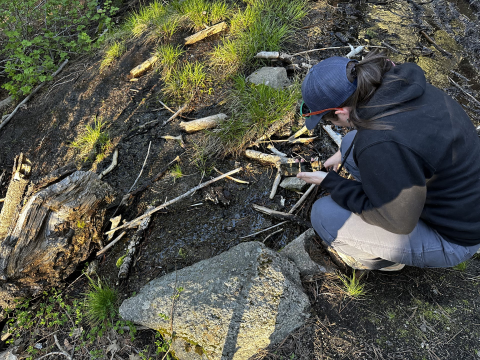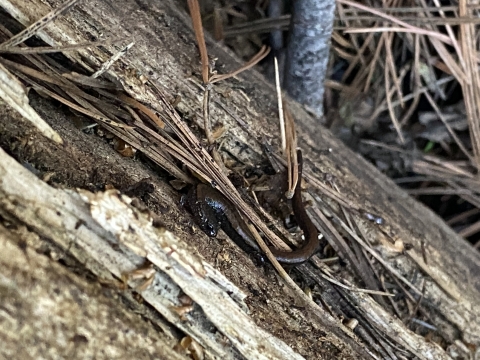Stepping carefully among the woody debris at the base of the ravine, Kate Bocskor, senior fish and wildlife biologist at the Sacramento Fish and Wildlife Office, scanned the moist earth for a rare salamander. This is the part of being a wildlife biologist that drew her to the field: exploring ecosystems and the species that call them home.
Bocskor has been evaluating the relictual and Kern Canyon slender salamanders of the Sequoia National Forest for nearly four years. Her work contributed to the proposal to list both salamanders under the Endangered Species Act. Yet despite the countless hours of reading, writing, and compiling data at her desk, she had only seen the salamanders from a handful of existing photos.
But that changed in early May when Bocskor got out from behind her desk to search for the two rare species. Casey Moss, a field technician with the U.S. Geological Survey and an expert in slender salamanders, and Sequoia National Forest biologist Ron Rozar led Bocskor and colleagues from the Sacramento Fish and Wildlife Office into the Kern River Canyon.
“We started looking around 1 p.m. in the lower Kern River Canyon, where Kern Canyon slender salamanders can still be found but seem to be disappearing,” said Bocskor. “Some of the locations haven’t had a sighting in decades. We didn’t find this species at those sites or, as it turned out, at any of the others we visited.”
They’re cryptic little things. Most active on rainy nights, Kern Canyon slender salamanders are colored like mud and hide in crevices within boulder outcrops or under moist logs like their invertebrate prey. With just a handful of sites in the lower Kern River Canyon serving as their remaining range, seeing a Kern Canyon slender salamander takes not only planning, but luck.
“Some of those lower sites are already too dry for salamanders to be at the surface,” said Moss. “In that sense, it wasn’t unusual to not find any. Higher up on Breckenridge Mountain, we began looking for the relictual slender salamander in places where their numbers have been declining over time, but where there was still a good chance of seeing one.”
Yet by 6 p.m., they still hadn’t seen either species, and evening was setting in. At the last site, water trickled into a ravine below a spring. The biologists carefully peeked under rocks and logs that looked like perfect cover objects for the relictual slender salamander. Nothing.
“We knew that last site was where we were most likely to see a salamander, so we were feeling pretty disappointed,” recalls Bocskor. “But then Ron Rozar called out that he found one! It was so exciting, and after that, we got a better idea of where to look. We ended up finding four.”
Sequoia National Forest has been conducting surveys to monitor water quality and is identifying methods for preserving and improving relictual slender salamander habitat. Their habitat can look like little more than a wet or muddy spot on the forest floor where a spring is bringing water to the surface. Staff have been working to prevent erosion around these areas and are maintaining habitat sites by leaving natural cover objects in place.
“One really gets a sense of how vulnerable these small and delicate animals are,” said Rozar. “Sequoia National Forest is eager to work with the Sacramento Fish and Wildlife Office and other partners to better understand where the salamanders can be found, what their precise habitat needs are, and how we can connect the populations at different sites in order to conserve these two amazing species.”
The U.S. Fish and Wildlife Service is currently determining the final listing status of the two species after public review of the proposed rule. If they are listed, the Service will consider the next steps to take in collaboration with Sequoia National Forest and other partners to recover the species.
“It was exciting enough to see their actual habitat after working on the species for so long, but to finally see individuals made the species and their plight more real,” said Bocskor. “I feel fortunate I get to contribute to the conservation of these unique salamanders.”






